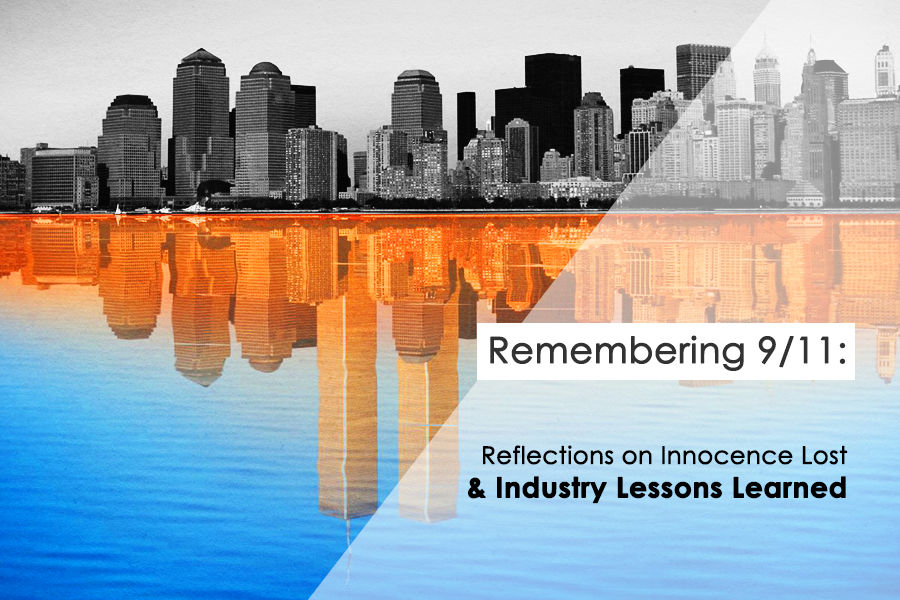Remembering 9/11: Reflections on Innocence Lost & Industry Lessons Learned
September 11, 2018

By Roy Hilliard, VP of Business Development, NJFX
Every year at this time, I think of the tragic events that unfolded on the morning of that beautiful September day in 2001. It seems like a lifetime ago, and just yesterday all at once. Everyone has a story to tell about where they were “when”. If you lived in the tri-state area, exactly where you were was pretty significant. Most people I know have a tale to tell about their experiences in lower Manhattan or know someone who did. It’s a day we remember as Americans for the loss of innocence that most of us felt. It’s a time to reflect on the souls who were lost. And it’s a day that will mark the end of era in many sectors. From the way we get on planes, to the way we do business – the September 11th attacks changed life as we knew it.
When the planes hit, I led the AT&T international product management group responsible for International Private Lines, Frame Relay, Asynchronous Transfer Mode, and Satellite services. When everything transpired, we were tasked to try to see what resources we could utilize. My team directly supported the Department of Defense, Department of Justice, Secret Service, and the State Department, which lost local connectivity and was scrambling. Most of what we could offer were satellite solutions from alternate centers, as much of what was local to New York city was equally offline with either physical damage, or local PoPs offline. Much of the connectivity had to be pushed farther south, either out of Florida or out of government owned facilities.
I recall that my peer within AT&T, who worked on the domestic side, was lost when it came to NYC, even though AT&T had a strong network and options. The events of September 11th were just too catastrophic to possibly solve for everyone affected. As the cleanup evolved and in a very ironic and difficult twist, we were able to install a 4M satellite dish on the roof of the Thomas Street AT&T PoP, to open more communication options for Europe. I say difficult and ironic because the site was previously unavailable to provide service as the Twin Towers blocked the trajectory. With both towers now downed by terrorists, the trajectory was clear for a signal. Overlooking ground zero from the roof is one of the images that I recall every year.
We have learned a lot since then. Telecommunications has changed dramatically as well. Now ubiquitous smart phones were still in their infancy in 2001. There are three things that I like to point to in terms of network security in the face of any disruption: diversity, resiliency, and redundancy. Global solutions require a new level of interconnectivity. Establishing access to interconnectivity hubs is how institutions will have the ability to safely control, monitor, maintain, and maximize the underlying network. By using these hubs in conjunction with advanced network orchestration, companies can insulate applications from isolation, vulnerability, and interruptions. Institutions historically engineered multiple paths but were beholden to what was offered by carriers as to routes and diversity. Much of this holds true today, however in the always on, always available climate, network design must get smarter for both the steady state and when systems are disrupted. Flexibility to control and redirect the network needs to be the new norm. The ability to do so comes back to having access to hubs that can maintain connectivity as well as offer alternate pathways.
As a recent example, NJFX played a key role in recovery during 2017’s active hurricane season, on standby to assist hubs in Puerto Rico and Florida struggling with power outages and capacity demands. Being available with critical services after a disruption event is vital for clients. The 2017 hurricane season renewed the focus on preparing options in advance. Entities and providers speak with us regularly about ways to ensure diverse, physical connectivity.
We will always have to worry about the next disruption, whether it comes in the form of a terrorist attack, a cyber threat or a natural disaster. But I believe as an industry we have learned, adapted and are more ready today than ever to address catastrophic events.
Image Credits: “Reflect” September 08, 2011
Advertising Agency: Extra Credit Projects, Grand Rapids, USA
Creative Director: Rob Jackson, Art Director: Joshua Best
###
About NJFX:
NJFX is a Tier 3 Carrier Neutral Cable Landing Station campus. Our colocation ecosystem has expanded to over 35 network operators offering flexibility, reliability, and security. Our Wall, NJ location provides direct access to multiple subsea cable systems giving our carriers diverse connectivity solutions and offers direct interconnection without recurring cross-connect fees.

